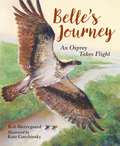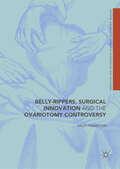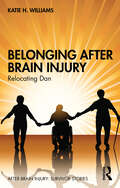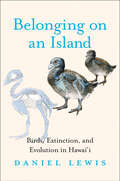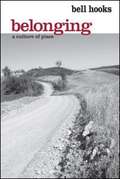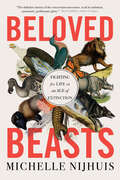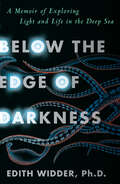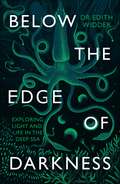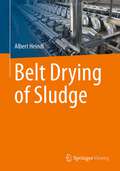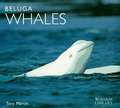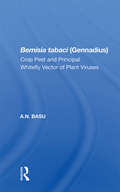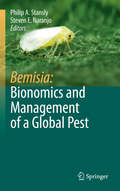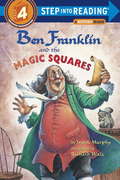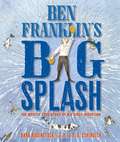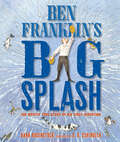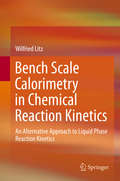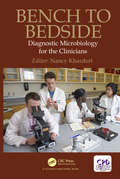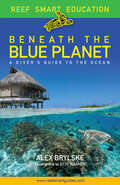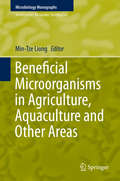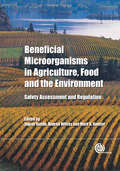- Table View
- List View
Belle's Journey: An Osprey Takes Flight
by Rob BierregaardTake flight with Belle, an osprey born on Martha's Vineyard as she learns to fly and migrates for the first time to Brazil and back--a journey of more than 8,000 miles.Dr. B. and Dick, two osprey scientists in Massachusetts, observe ospreys and their offspring, tagging one special fledgling with a transmitter to better study migration habits. Follow Belle as she attempts her first flight, conquers her first fishing endeavour, and heads south for her first migration all while her tracking device transmits information about where's she been. Based on information garnered through twenty years of research by the author, Belle's Journey will soar into reader's hearts.
Belly-Rippers, Surgical Innovation and the Ovariotomy Controversy (Medicine and Biomedical Sciences in Modern History)
by Sally FramptonThis open access book looks at the dramatic history of ovariotomy, an operation to remove ovarian tumours first practiced in the early nineteenth century. Bold and daring, surgeons who performed it claimed to be initiating a new era of surgery by opening the abdomen. Ovariotomy soon occupied a complex position within medicine and society, as an operation which symbolised surgical progress, while also remaining at the boundaries of ethical acceptability. This book traces the operation’s innovation, from its roots in eighteenth-century pathology, through the denouncement of those who performed it as ‘belly-rippers’, to its rapid uptake in the 1880s, when ovariotomists were accused of over-operating. Throughout the century, the operation was never a hair’s breadth from controversy.
Belonging After Brain Injury: Relocating Dan (After Brain Injury: Survivor Stories)
by Katie H. WilliamsBelonging After Brain Injury: Relocating Dan explores the life of the author’s brother who has dealt with the effects of a severe traumatic brain injury (TBI) for over four decades. It recounts the institutional, psychological, and social labyrinths he and his family have navigated following the TBI he sustained at the age of eighteen. This insightful volume offers a holistic account of the impact of TBI on the survivor and his family. It reveals the difficulties a TBI survivor has had to endure and provides practical information about physical, psychological, and psychosocial symptoms and their consequences. Dan’s story offers new perspectives and strategies that will help alleviate seemingly intractable problems and highlights the central importance of forming connections with others in order to lead a fuller life. The author’s account of her own journey, learning to help care for and advocate for Dan, offers an invaluable guide for TBI survivors and those who care for and support them. Belonging After Brain Injury: Relocating Dan will be of interest to TBI survivors and their families. Its rich insights will be essential reading for medical and mental health professionals, as well those involved in the care and rehabilitation of TBI survivors and families.
Belonging on an Island: Birds, Extinction, and Evolution in Hawai'i
by Daniel Lewis“A book devoted to the beauty of [Hawaiian] birds . . . is a welcome event. [It] will be both an elegy and an important record of what has been lost to us all.” —W. S. Merwin, Pulitzer Prize–winning poet, The Shadow of SiriusA lively, rich natural history of Hawaiian birds that challenges existing ideas about what constitutes biocultural nativeness and belongingThis natural history takes readers on a thousand-year journey as it explores the Hawaiian Islands’ beautiful birds and a variety of topics including extinction, evolution, survival, conservationists and their work, and, most significantly, the concept of belonging. Author Daniel Lewis, an award-winning historian and globe-traveling amateur birder, builds this lively text around the stories of four species—the Stumbling Moa-Nalo, the Kaua‘I ‘O‘o, the Palila, and the Japanese White-Eye.Lewis offers innovative ways to think about what it means to be native and proposes new definitions that apply to people as well as to birds. Being native, he argues, is a relative state influenced by factors including the passage of time, charisma, scarcity, utility to others, short-term evolutionary processes, and changing relationships with other organisms. This book also describes how bird conservation started in Hawai‘i, and the naturalists and environmentalists who did extraordinary work.“With insight, humor, scholarship, and love, Daniel Lewis illustrates how and why the question of who or what “belongs” somewhere is both deceptively complex and increasingly important in today’s Anthropocene world.” —Robert J. Cabin, author of Restoring Paradise: Rethinking and Rebuilding Nature in Hawai‘i“Lewis’s fascinating story of Hawaii is, in microcosm, the history of humans on our fragile Earth.” —Bruce M. Beehler, National Museum of Natural History, Smithsonian Institution
Belonging: A Culture of Place
by Bell HooksWhat does it mean to call a place home? Who is allowed to become a member of a community? When can we say that we truly belong? These are some of the questions of place and belonging that renowned cultural critic Bell Hooks examines in this book.
Beloved Beasts: Fighting For Life In An Age Of Extinction
by Michelle NijhuisOne of Literary Hub's Most Anticipated Books of 2021 A vibrant history of the modern conservation movement—told through the lives and ideas of the people who built it. In the late nineteenth century, as humans came to realize that our rapidly industrializing and globalizing societies were driving other animal species to extinction, a movement to protect and conserve them was born. In Beloved Beasts, acclaimed science journalist Michelle Nijhuis traces the movement’s history: from early battles to save charismatic species such as the American bison and bald eagle to today’s global effort to defend life on a larger scale. She describes the vital role of scientists and activists such as Aldo Leopold and Rachel Carson as well as lesser-known figures in conservation history; she reveals the origins of vital organizations like the Audubon Society and the World Wildlife Fund; she explores current efforts to protect species such as the whooping crane and the black rhinoceros; and she confronts the darker side of conservation, long shadowed by racism and colonialism. As the destruction of other species continues and the effects of climate change escalate, Beloved Beasts charts the ways conservation is becoming a movement for the protection of all species—including our own.
Below the Edge of Darkness: A Memoir of Exploring Light and Life in the Deep Sea
by Edith WidderA pioneering marine biologist takes us down into the deep ocean to understand bioluminescence—the language of light that helps life communicate in the darkness—and what it tells us about the future of life on Earth. <p><p> Edith Widder’s childhood dream of becoming a marine biologist was almost derailed in college, when complications from a surgery gone wrong caused temporary blindness. A new reality of shifting shadows drew her fascination to the power of light—as well as the importance of optimism. As her vision cleared, Widder found the intersection of her two passions in oceanic bioluminescence, a little-explored scientific field within Earth’s last great unknown frontier: the deep ocean. <p><p> With little promise of funding or employment, she leaped at the first opportunity to train as a submersible pilot and dove into the darkness. Widder’s first journey into the deep ocean, in a diving suit that resembled a suit of armor, took her to a depth of eight hundred feet. She turned off the lights and witnessed breathtaking underwater fireworks: explosions of bioluminescent activity. Concerns about her future career vanished. She only wanted to know one thing: Why was there so much light down there? <p><p> Below the Edge of Darkness takes readers deep into our planet’s oceans as Widder pursues her questions about one of the most important and widely used forms of communication in nature. In the process, she reveals hidden worlds and a dazzling menagerie of behaviors and animals, from microbes to leviathans, many never before seen or, like the legendary giant squid, never before filmed in their deep-sea lairs. Alongside Widder, we experience life-and-death equipment malfunctions and witness breakthroughs in technology and understanding, all set against a growing awareness of the deteriorating health of our largest and least understood ecosystem. A thrilling adventure story as well as a scientific revelation, Below the Edge of Darkness reckons with the complicated and sometimes dangerous realities of exploration. Widder shows us how when we push our boundaries and expand our worlds, discovery and wonder follow. These are the ultimate keys to the ocean’s salvation—and thus to our future on this planet.
Below the Edge of Darkness: Exploring Light and Life in the Deep Sea
by Edith Widder'A book of marvels, marvellously written' RICHARD DAWKINSA pioneering marine biologist takes us down into the deep ocean to understand bioluminescence, the language of light that helps life communicate in the darkness, and what it tells us about the future of life on Earth.Edith Widder grew up determined to become a marine biologist. But after complications from a surgery during college caused her to go temporarily blind, she became fascinated by light as well as the power of optimism. Her focus turned to oceanic bioluminescence, a scientific frontier, and with little promise of funding or employment she took a leap into the dark. Below the Edge of Darkness explores the depths of the planet's oceans as Widder seeks to understand one of the most important and widely used forms of communication in nature. In the process, she reveals hidden worlds and a dazzling menagerie of behaviours and animals, many never-before-seen or, like the legendary Giant Squid, never-before-filmed in its deep-sea lair. Alongside Widder, we experience life-and-death equipment malfunctions and witness breakthroughs in technology and understanding, all of it set against a growing awareness of the deteriorating health of our largest and least understood ecosystem.This is an adventure story as well as a science story. But it's also about the sometimes complicated business of exploration. And ultimately, Widder shows us that exploration, and the corresponding senses of discovery and wonder, are the keys to the ocean's salvation and thus our future on this planet.'Edie's story is one of hardscrabble optimism, two-fisted exploration and groundbreaking research. As I've said many times, I'd have wrapped my submersible, the DEEPSEA CHALLENGER, in bacon if it would have lured the elusive giant squid from the depths. In Below the Edge of Darkness, Edie tells you how she did it' JAMES CAMERON
Below the Edge of Darkness: Exploring Light and Life in the Deep Sea
by Edith WidderA pioneering marine biologist takes us down into the deep ocean in this 'thrilling blend of hard science and high adventure' (The New York Times)Edith Widder grew up determined to become a marine biologist. But after complications from a surgery during college caused her to go temporarily blind, she became fascinated by light as well as the power of optimism. Below the Edge of Darkness explores the depths of the planet's oceans as Widder seeks to understand bioluminescence, one of the most important and widely used forms of communication in nature. In the process, she reveals hidden worlds and a dazzling menagerie of behaviours and animals. Alongside Widder, we experience life-and-death equipment malfunctions and witness breakthroughs in technology and understanding, all of it set against a growing awareness of the deteriorating health of our largest and least understood ecosystem.'A vivid account of ocean life' ROBIN MCKIE, GUARDIAN BOOK OF THE DAY'Edie's story is one of hardscrabble optimism, two-fisted exploration and groundbreaking research. She's done things I dream of doing' JAMES CAMERON'A book of marvels, marvellously written' RICHARD DAWKINS
Belt Drying of Sludge
by Albert HeindlThis professional book deals with belt drying of sewage sludge, mainly of municipal but also of industrial origin. The wastewater treatment resulting in sludge production is briefly described. The types of sludge and their degree of stabilization is treated in depth as they have a high impact on their suitability for belt drying and the necessary exhaust air treatment. Different belt drying systems with or without condensing units and with extruding of dewatered sludge or partial recirculation of dried sludge are presented. Specific water evaporation and energy demand are tabulated for each dryer system on basis of indications of dryer manufacturers, measurements or information of dryer operators. Different sources for thermal energy are stipulated and complete systems of energy supply with internal or external usage of exhaust energy described. Occurring gas compounds in dryer exhaust air and their special features are mentioned in depth. The components and complete systems for exhaust air cleaning are discussed also in their efficiency of removal of individual odorous gas components or of total amount of volatile organic compounds. Conveying systems and storage of dewatered sludge as well as of dried sludge are described together with the related safety issues. Dryer control as well as ATEX, SIL and HAZOP issues and economic aspects are discussed briefly in individual chapters. The book will be useful for engineering enterprises and consultants designing belt drying systems for sludge, but will also transfer useful information to operators. Also authorities dealing with the permission of sludge drying plants will find important aspects with regard to environmental protection and reasonable economic and continuous operation under safe conditions.
Beluga Whales (Worldlife Library)
by Tony MartinFrom the book jacket: get close to belugas in their natural environment in this engaging introduction. Anthony Martin - who has been studying belugas for more than seventeen years - will acquaint you with the beluga's physical characteristics and behavior, along with conservation issues, and the practical and moral issues raised by keeping belugas in captivity. In addition, you can enjoy more than fifty spectacular pictures of this photogenic whale known for its wide range of facial expressions. Discover the world's animals in the WorldLife Library by Voyageur Press. This highly acclaimed series brings you the latest research from leading naturalists, along with stunning color photographs of your favorite animals.
Bemisia Tabaci (Gennadius): Crop Pest And The Principal Whitefly Vector Of Plant Viruses
by A.N. BasuThis monograph provides information on the basic and applied research on the morphology, taxonomy, biology, ecology and behaviour of the whitefly, Bemisia tabaci (Gennadius). It is devoted to the epidemiology of the diseases transmitted by the whitefly and the approaches to control.
Bemisia: Bionomics And Management Of A Global Pest
by Philip A. Stansly Steven E. NaranjoBemisia tabaci (Gennedius) has distinguished itself from the more than 1,000 whitefly species in the world by its adaptability, persistence and potential to damage a wide range of agricultural and horticultural crops in all six of the world's inhabited continents. B. tabaci inflicts plant damage through direct feeding, inducement of plant disorders, vectoring of plant viruses and excretion of honeydew. This book collates multiple aspects of the pest ranging from basic to applied science and molecular to landscape levels of investigation. Experts in multiple disciplines provide broad, but detailed summaries and discussion of taxonomy, genetics, anatomy, morphology, physiology, behavior, ecology, symbiotic relationships, virus vector associations and various tactics for integrated management of this pest insect. The book is focused primarily on progress during the last 10-15 years and is directed at workers in the field as well as the informed professional who may not necessarily specialize in whitefly research. The book is unique in providing broad coverage in relatively few chapters by recognized experts that highlight the state-of-the-art in our understanding of this fascinating but troublesome cosmopolitan pest.
Ben Franklin and the Magic Squares (Step into Reading)
by Richard Walz Frank MurphyA funny, entertaining introduction to Ben Franklin and his many inventions, including the story of how he created the "magic square." A magic square is a box of nine numbers arranged so that any line of three numbers adds up to the same number, including on the diagonal! Teachers and kids will love finding out about this popular teaching tool that is still used in elementary schools today!
Ben Franklin's Big Splash: The Mostly True Story Of His First Invention
by S. D. Schindler Barb RosenstockEvery inventor has to start somewhere, and one of the greatest innovators in our history was no exception. Ben Franklin developed his first invention while doing what he loved best: swimming! Ben's Big Splash is the story of Franklin's first invention, his journey through the scientific method, and the surprising successes that result when you're willing to make mistakes. Barb Rosenstock's rhythmic, whimsical style is the perfect complement to S. D. Schindler's pen and ink and watercolor illustrations. Together they recreate history in an engaging and unique way. Both author and illustrator worked closely with Franklin experts, and the book includes Franklin quotes, an extensive author's note, timeline, and bibliography.
Ben Franklin's Big Splash: The Mostly True Story of His First Invention
by Barb RosenstockA National Science Teachers Association, Best STEM BookHere is the story of Ben Franklin's first invention, his journey through the scientific method, and the surprising successes that result when you're willing to make mistakes.Every inventor has to start somewhere, and one of the greatest innovators in our history was no exception. Ben Franklin developed his first invention while doing what he loved best: swimming! Barb Rosenstock's rhythmic, whimsical style is the perfect complement to S. D. Schindler's pen and ink and watercolor illustrations. Together they recreate history in an engaging and unique way. Both author and illustrator worked closely with Franklin experts, and the book includes Franklin quotes, an extensive author's note, timeline, and bibliography.
Bench Scale Calorimetry in Chemical Reaction Kinetics: An Alternative Approach to Liquid Phase Reaction Kinetics
by Wilfried LitzThis book describes new and efficient calorimetric measurement methods, which can be used to accurately follow the chemical kinetics of liquid phase reaction systems. It describes apparatus and techniques for the precise measuring of the rate of heat liberation in discontinuous and continuous isothermal as well as non-isothermal reactions. The presented methodology can be used to follow the development of chemical reactions online, even in industrial scales. Written by an experienced scientist and practitioner, who can look back on long-standing expert knowledge in chemical engineering, the book contains many practical hints and instructions. The reader will find a sound compact introduction to fundamentals, and comprehensive technical background information and instructions for performing own kinetic experiments. This book is the fusion of scientific background information and long hands-on experience in the practice.
Bench to Bedside: Diagnostic Microbiology for the Clinicians
by Nancy KhardoriThis reference text is a must have for any current or future clinicians or students of microbiology. It is concisely organized to provide vital information on many of the microbes one will regularly encounter and the most efficacious ways of addressing associated infections. Discussion of antimicrobial resistance mechanisms and measures to combat them are also one of the key features of this text. Whether you desire to utilize this book at the bedside for prompt treatment decisions or as a reference manual to be used at your leisure, you will find it to be a valuable addition to your library.
Beneath the Blue Planet: A Diver's Guide to the Ocean and Its Conservation (Reef Smart Education)
by Alex BrylskeTake a Deep Dive into the Secrets of Our Blue Planet"The author is one of the most experienced in the world. A fascinating and engaging toom. Well worth the read. A valued forever reference." —Amazon review#1 New Release in Scuba Travel GuidesVenture into the thrilling realm of underwater exploration with Beneath the Blue Planet by the founders of the popular Reef Smart Guides series for snorkelers and scuba divers. A perfect travel gift for nature lovers and a rich source of shark facts, this book unearths the secrets of the ocean, from coral reefs to the world of deep diving.Dive into the ocean's untold stories. Discover the captivating universe that exists beneath the waves. From the diverse inhabitants of the coral reefs to the deepest, most mysterious corners of the ocean, Beneath the Blue Planet unveils everything you've ever wanted to know about our underwater world.Experience the thrill of ocean exploration. This immersive guide provides fascinating shark facts, explores the incredibly beautiful world of coral reefs, and encourages sustainable tourism for divers. Designed for anyone who loves the ocean, this book is a treasure trove of knowledge, making it an excellent travel gift for adventure seekers.Immerse yourself in Beneath the Blue Planet and:Unearth the hidden world of ocean reefs, and understand their essential role in marine ecosystemsGain invaluable insights into snorkeling and deep diving, enhancing your ocean exploration adventuresExplore intriguing shark facts, providing a closer look at these fascinating marine creaturesDiscover practical ways to contribute to ocean conservation, turning your love for the seas into meaningful actionIf you've read Oceanology, National Geographic A Diver's Guide to the World, or100 Dives of a Lifetime, and are a fan of the Reef Smart Guides dive and snorkel travel series, you’ll love Beneath the Blue Planet.
Beneath the Surface: Understanding Nature in the Mullica Valley Estuary
by Kenneth W. AbleThe Mullica Valley estuary and its watershed, formed over the last 10,000 years, are among the cleanest estuaries along the east coast of the United States. This 365,000-acre ecosystem benefits from a combination of protected watershed, low human population density, and general lack of extensive development. In Beneath the Surface, marine scientist Ken Able helps the reader penetrate the surface and gain insights into the kinds of habitats, animals, and plants that live there. Readers will gain a better understanding of the importance of these shallow waters; how the amount of salt in the water determines where animals and plants are found in estuaries; the day-night, seasonal, and annual variation in their occurrence; and how change is occurring as the result of climate variation. Throughout the book are insightful sidebars telling intimate stories of where various animals came from and where they are going as they travel through the estuary on their way to and from other portions of the east coast. Beneath the Surface emphasizes the kinds and importance of the animals and plants that live beneath the surface of this unique ecosystem.
Beneficial Chemical Elements of Plants: Recent Developments and Future Prospects
by Vijay Pratap Singh Shivesh Sharma Durgesh Kumar Tripathi Devendra Kumar Chauhan Sangeeta PandeyBENEFICIAL CHEMICAL ELEMENTS OF PLANTS Understand beneficial elements and their role in the future of botany and agriculture Beneficial elements are those which, while not essential to plant life, can provide stimulation and enhance plant growth. Properly harnessed, these elements can bolster plant growth in the face of environmental conditions—including drought, nutrient deficiency, and excessive soil salinity—and biotic stresses like pathogens and animal activity. As climate change and population growth pose increasingly serious challenges to agriculture and essential plant production, it has never been more important to unleash the potential of beneficial elements. Beneficial Chemical Elements of Plants is an essential resource for researchers and industry specialists looking to enhance their understanding of these elements and the range and variety of their enhancements to plant growth. Written by leading scholars in the field of plant stress tolerance and nutrient enrichment, it discusses not only the rich possibilities of beneficial elements but their mechanisms of action at both biochemical and molecular levels. It details the precise potential roles played by each major beneficial element and surveys a range of elemental responses to specific environmental conditions and plant stresses. Beneficial Chemical Elements of Plants readers will also find: Chapters covering beneficial elements including aluminum, cobalt, sodium, selenium, and silicon Discussion of application methods and typical plant responses Treatment of beneficial elements in a wider environmental context Beneficial element applications to the field of sustainable agriculture Beneficial Chemical Elements of Plants is a fundamental starting point for researchers and students in the fields of plant physiology, crop science, agriculture, and botany, as well as for professionals in the biotechnology and agricultural industries.
Beneficial Insects
by David AlfordInsects are key components of life on our planet, and their presence is essential for maintaining balanced terrestrial ecosystems. Without insects humans would struggle to survive, and on a world scale food production would be severely compromised. Many plants and animals depend directly or indirectly on insects for their very survival, and this is particularly so in the case of insectivorous birds and other such creatures. The beneficial role of insects is often overlooked or misunderstood, and in farming circles their very presence on crops is often seen to be unwelcome. In reality, however, many insects are genuinely beneficial, as in the case of parasitic and predacious species. The use of chemical pesticides to control crop pests is becoming more tightly regulated and environmentally undesirable, and low-input farming, in which natural enemies of pests are encouraged to survive or increase, is becoming far more prevalent. Accordingly, Integrated Pest Management (IPM) and Integrated Pest Management (ICM) strategies are increasingly being developed, advocated and adopted. <p><p>Features: <li>Highlights information on many groups of insects and mites that act as natural enemies or biological control agents of phytophagous insects and mites, including plant pests. <li>Profusely illustrated with high-quality colour photographs. <li>Focuses mainly on insects and mites as natural enemies of plant pests, including parasitic and predacious species that have been accidentally or deliberately introduced in classical biological control programmes. <li>Reviews the role of phytophagous European insects and mites in controlling or managing European plants that have become invasive weeds in other parts of the world, notably North America, Australia and New Zealand.
Beneficial Microorganisms in Agriculture (Environmental and Microbial Biotechnology)
by Ram Prasad Shi-Hong ZhangThis book discusses genetic engineering of both plants and microbes for making agricultural practices more productive and sustainable. It chapters explore the understanding of the interaction between plants and microbes, and genomic information to modify the metabolism of plants or microbes to further enhance the beneficial interaction. The book covers the development of commercial inoculants including selection of appropriate plant growth-promoting rhizobacteria/ phosphate solubilize bacteria based on target host plant, soil type, indigenous microbial communities, environmental conditions, inoculant density, suitability of carriers and compatibility with integrated crop management. This is a relevant content for scientists and researchers working on soil biology, sustainable agricultural and plant physiology. Also, this book is a useful read for graduate and post graduate students of agriculture, botany and microbiology.
Beneficial Microorganisms in Agriculture, Aquaculture and Other Areas (Microbiology Monographs #29)
by Min-Tze LiongThis book focuses on the use of microorganisms in relation to agriculture, aquaculture and related fields, ranging from biofertilizers to poultry production. The latest innovations are also included to provide insights into the unlimited potentials of microorganisms in these areas. Individual chapters explore topics such as probiotics in poultry, biopurification of wastewater, converting agrowastes into value-added applications and products, rice cultivation, surfactants and bacteriocin as biopreservatives, bioplastics, crop productivity, biofloc, and the production of natural antibiotics. This volume will be of particular interest to scientists, policymakers and industrial practitioners working in the fields of agriculture, aquaculture and public health.
Beneficial Microorganisms in Agriculture, Food and the Environment
by Atte Von Wright Stephen Jaronski Carl-Gustaf Thornstrom Andrea Wilcks Keith Warner Ingvar Sundh Stephen Wessels Avrelija Cencic Milton Typas Barbara Pernfuss Roland Mollby Niels Hendriksen John Howieson Rudiger Hauschild Peter Van Baarlen Anne Madsen Michael Frodyma C Kurz Claude Alabouvette Mark Goettel Trudy Wassenaar Jeroen Meussen Harry Evans Gregorio Loprieno Andrew Chesson Michael WisniewskiMicroorganisms are widely used in various beneficial applications, including food, pest control, bioremediation, biodegradation, biofuel processes, and plant symbiosis and growth stimulation. his book provides an overview of the available methodology for safety assessments of microorganisms, including determination of their infectivity and whether they produce toxic or sensitising substances. Also covered are the regulatory systems in risk assessment and management of microbial products, quarantine legislations, international treaties, the importance of public risk perception and risk reduction behaviour.
